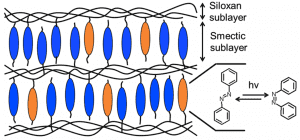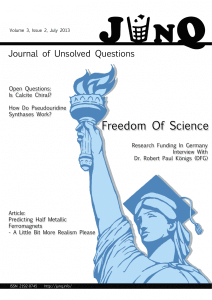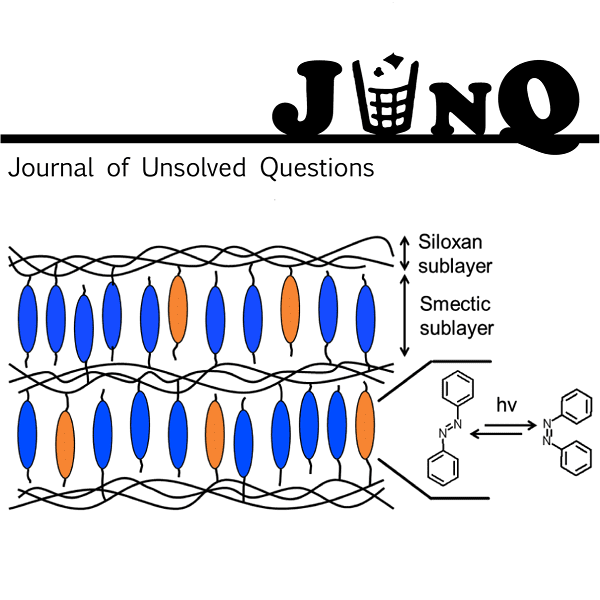Liquid crystalline (LC) elastomers are well known for their reversible shape variation at the phase transition from the LC to the isotropic phase. The Group of R. Zentel managed to prepare an oriented smectic monodomain of a crosslinked LC-polysiloxane, which showed – contrary to the expectations – NO shape variation at all.![]()
Liquid crystalline elastomers (LC-elastomers) combine LC-phases and the resulting anisotropic properties with the mechanical properties of a soft rubbery solid. As a consequence the conformation of the polymer chains is influenced by the liquid crystalline director field. This couples the shape of the LC-elastomer to the liquid crystalline order. LC-elastomers are presently finding an increasing interest as actuators. Generally size changes are found at phase transition temperatures, especially at the transition from the ordered liquid crystalline phase (e.g. smectic or nematic) to the disordered isotropic phase.
Generally size changes are found at phase transition temperatures, especially at the transition from the ordered liquid crystalline phase (e.g. smectic or nematic) to the disordered isotropic phase.
R. Zentel and coworkers successfully synthesized azo containing smectic LC-polymers, which could (for the first time) be photocrosslinked into smectic elastomers. However, when they wanted to study their shape variation at the transition from the smectic A to the isotropic phase, no shape variation could be observed. It is completely unknown, why this type of “diluted” LC-polysiloxane (only about 25% of the repeating units are functionalized with mesogens) behaves like this.
 You can find the article on the website of the Journal of Unsolved Questions for free.
You can find the article on the website of the Journal of Unsolved Questions for free.
An unexpected result! But is it useful? Critics might say it’s not, because the material is not doing what it’s supposed to do. However, from a scientific point of view I think we can agree it is an important result, since it raises the question: why does it not do what we expect it to do? The answer to that question would certainly lead to a better general understanding of LC-elastomers.
 The Journal of Unsolved Questions (JUnQ) has been publishing results like these since their first issue, published in 2011. Many research projects are producing ambiguous or “null”-results that don’t lead to unambiguous conclusions. Nevertheless this “failed” research provides useful and valuable information for fellow scientists. Many scientists feel that only research projects with positive results and clear conclusions have the chance to get published in scientific journals. Due to this, a lot of information is lost for the scientific community and additionally scientists find themselves in the dilemma of having to overinterpret their data.
The Journal of Unsolved Questions (JUnQ) has been publishing results like these since their first issue, published in 2011. Many research projects are producing ambiguous or “null”-results that don’t lead to unambiguous conclusions. Nevertheless this “failed” research provides useful and valuable information for fellow scientists. Many scientists feel that only research projects with positive results and clear conclusions have the chance to get published in scientific journals. Due to this, a lot of information is lost for the scientific community and additionally scientists find themselves in the dilemma of having to overinterpret their data.
The Journal of Unsolved Questions (JUnQ) provides a means to gather “null”-result research and open problems. JUnQ is a platform to communicate — without exaggeration — projects, which just didn’t work as expected or produced ambiguous data as well as investigations, which raise more questions than they answer.
Apart from research papers, the journal also publishes essays and interviews on specific topics, the newest issue dealing with the freedom of science.

















